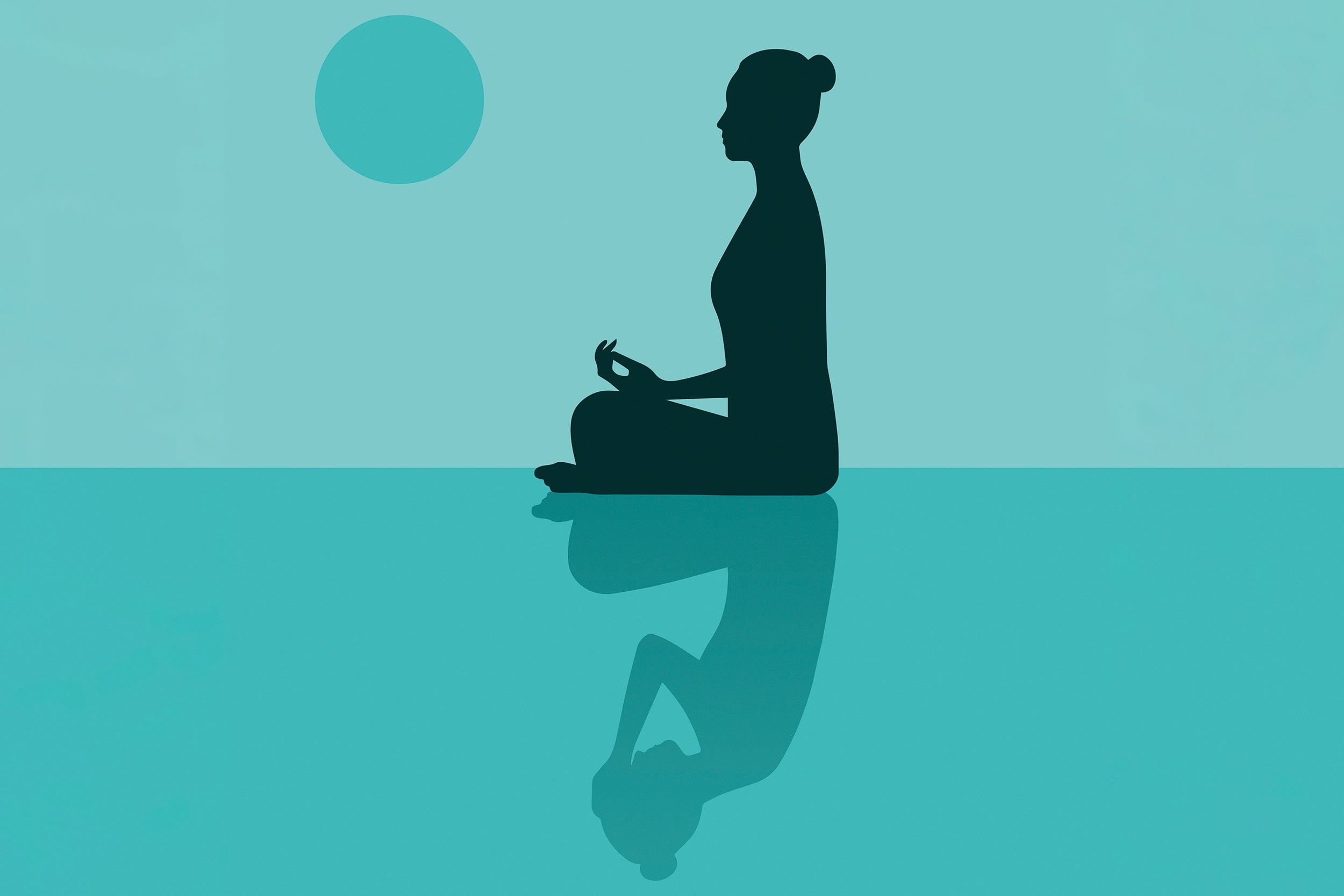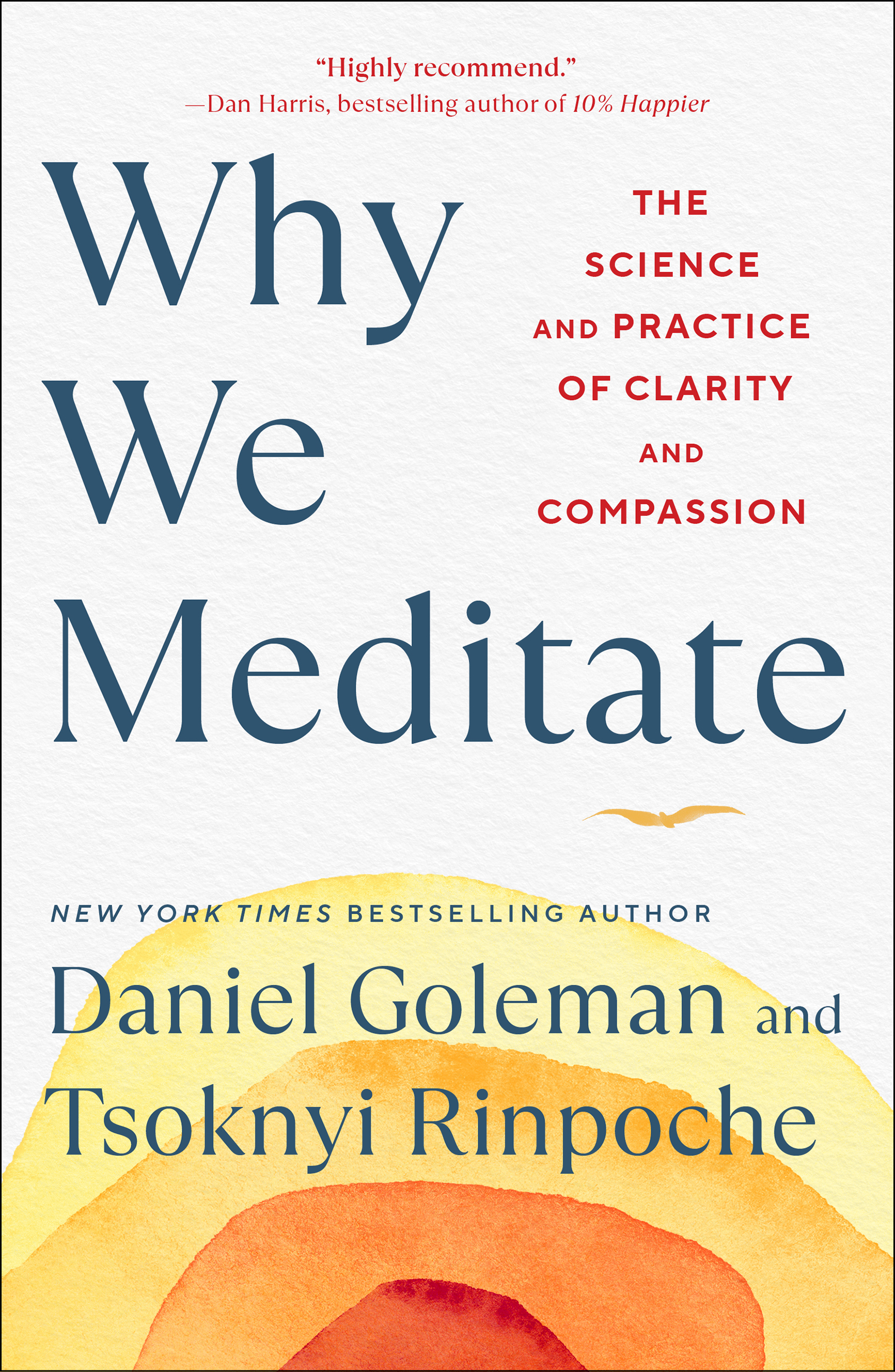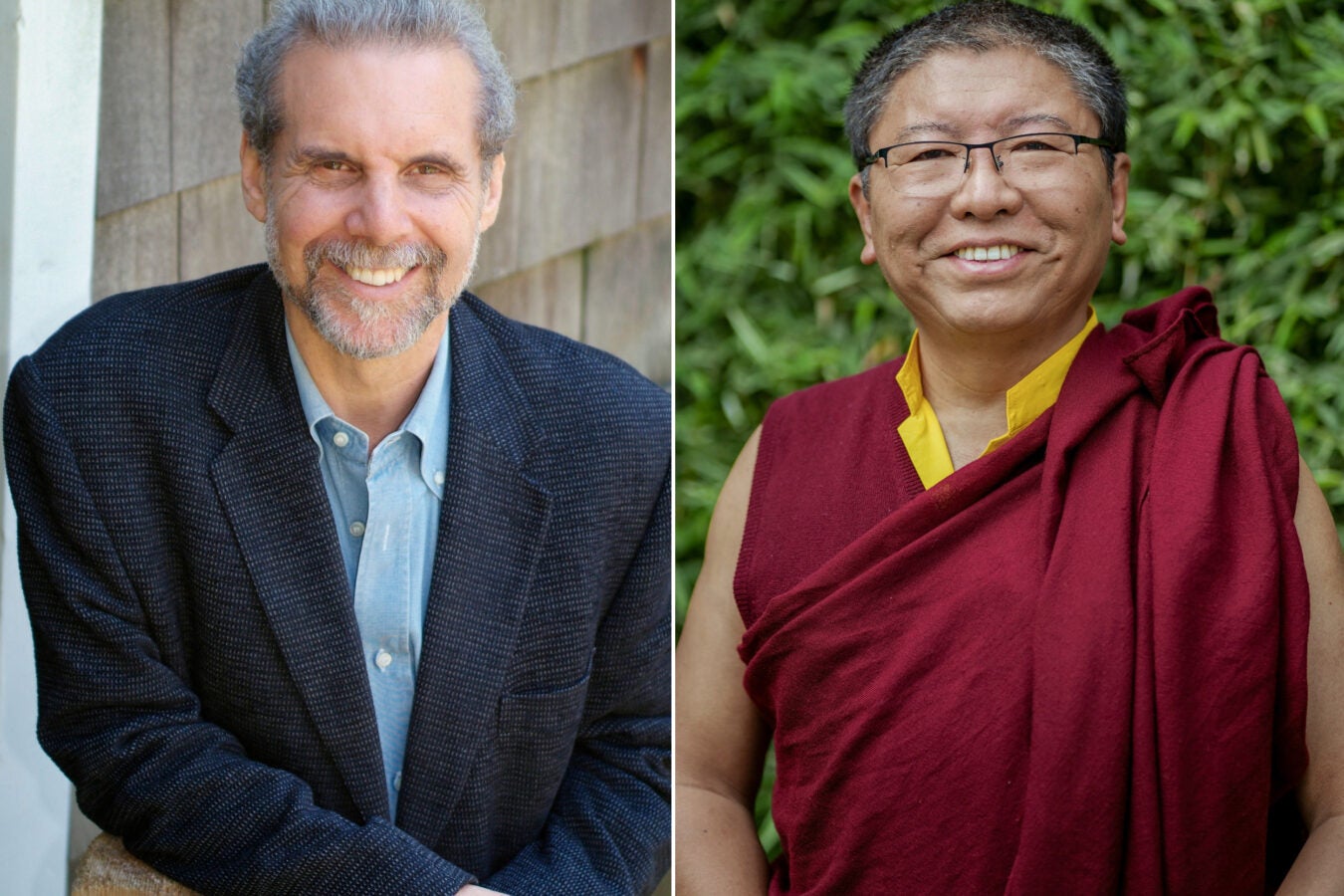
Illustration by Nick Lowndes
Excerpt from ‘Why We Meditate’
Daniel Goleman, Tsoknyi Rinpoche walk us through science, practice of meditation in book excerpt.
Another in series of pieces about resetting our lives for a healthier new year. Excerpted from “Why We Meditate: The Science and Practice of Clarity and Compassion” by Daniel Goleman, Ph.D. ’74, and Tsoknyi Rinpoche, with Adam Kane.
My wife and I were in a taxi with Tsoknyi Rinpoche on the way to the Delhi train station. It was March 2000, and we had reservations on a train that would take us up toward Dharamshala, where I would moderate a meeting with the Dalai Lama and a handful of psychologists on the topic of “Destructive Emotions.”
We had left with plenty of time to spare, but gridlocked traffic was eating away at the time buffer. I was, frankly, getting uptight, increasingly worried about missing the train — a destructive emotion had taken control.
My anxiety boiled over when our taxi stopped for a red light at the intersection of two huge avenues, which looked less like streets and more like parking lots packed with cars (and the occasional oxcart, bicycle rickshaw, and cow). The red light stopped us for what seemed like an endless amount of minutes.
A silver-colored word in the middle of that red light — relax — made no difference in my state. I could not relax, but got more and more tense. My head spun with the swarming colors, sounds, and smells whirling around us like a hurricane. Though our lanes weren’t moving anywhere, drivers all around us were showing their impatience in a rising cacophony of honking. I felt a mounting sense of urgency at the traffic jam, an impossible pretzel that had no rhyme nor reason and seemed would never untangle.
“Oh man!” I said to Rinpoche. “This traffic is really snarled. I’m starting to worry about getting to the train.”
Rinpoche said, in a soft, calm voice, “Can you feel the speediness? Can you find where it is?”
I closed my eyes and scanned my body, noticing a buzz of sensations and a growing tightness in my belly. I nodded.
Rinpoche continued, “Find it. Feel it. It’s not you. It’s not your mind, not your body. It’s your energy.”
Rinpoche added, “First just sense that you are speedy — what that feels like in your body. Then understand that you are tuning into the feeling world. Find where in your body you feel your energy’s speediness. Then breathe in and hold the breath down under your navel for as long as is comfortable for you. Exhale slowly, holding back about 10 percent of the air.”
Getting what he was saying, I took a deep breath and let the air out slowly.
Rinpoche led me through several breaths this way. And, almost miraculously, my tension eased. The light changed, traffic moved again, and I felt more relaxed.
Right on the spot, Rinpoche was guiding me to use the body scan and the gentle vase breathing method. These breath-control practices are ancient in India, and made their way from there, along with Buddhism, to Tibet in the ninth to 11th centuries. Several such breath-control practices have been preserved and are still taught in various corners of Tibetan Buddhism to this day.
Their purpose: calming the mind for meditation. Science agrees.
 It turns out there is sound research showing the power of these breath methods. In recent decades scientists have turned their attention to them, realizing that using them has powerful impacts on our mental state. In short, managing our breath helps us manage our mind.
It turns out there is sound research showing the power of these breath methods. In recent decades scientists have turned their attention to them, realizing that using them has powerful impacts on our mental state. In short, managing our breath helps us manage our mind.
Key parts of the brain’s emotional circuitry get triggered by a threat. In today’s stressful life this neural radar fires far more than needed, and the speediness we are caught up in adds to our stress.
That pitches us into “sympathetic nervous system” activity, where our body prepares for an emergency: Our heart rate jumps, as does blood pressure; our bronchial passages enlarge, and we breathe faster; our digestion shuts down; blood shifts from our organs to our arms and legs (the better to fight or run); and we sweat.
Such emergency responses are triggered by hormones like adrenaline and cortisol, which mobilize all these systems to prepare for emergency. This biological reaction gets set off all too often these days. (That irksome too-slow driver! That scary fast driver! Difficulty with the kids! That horrible boss!)
Once stress hormones surge through us, we’re more readily triggered for a further stress reaction. This threat reaction triggers in response to symbolic threats too — like the feeling that someone is treating us unfairly — not just the physical survival emergency the reaction was designed for. Being treated unfairly feels bad, of course. But it’s not the threat to our very life that our fight-or-flight response was designed to handle. Even so, that biological machinery for physical survival also takes over when we undergo a psychological threat like unfair treatment.
We can undergo this fight-or-flight response many times in a single day, all too often without having time to end it. And such a prolonged, ongoing fight-or-flight reaction overtaxes our biology with long-term costs, such as heightened inflammation, lowered immune system defenses, and becoming more susceptible to a range of stress-worsened illnesses.
During the emergency mode our attention shifts to focus on the presumed threat — even when we’re trying to get something else more important done, we stay preoccupied by what upsets us. This kind of anxious worry serves no useful purpose. Some of us might get sad or angry, while others panic. There’s no set response, but none of the likely reactions help us.
Contrast that with a “parasympathetic response,” the physiological state where the body rests and recovers from such stress. Our heart rate and blood pressure subside and our breath slows, as do the other biological upshifts of the emergency reaction. Our digestion resumes its usual workings. This is the biological state where the body rests, restores itself, and relaxes. We can eat, have sex, sleep.
The body’s emergency response has a beginning — when we’re triggered — a peak in the middle, and an end, if we have the chance to calm down again. That’s what the controlled breathing method Rinpoche offers here does for us: It ends the stress cycle we’re caught up by.
Meditation as stress reduction
I had the benefits of yogic practices like these breath-control methods in mind when I came back to Harvard from 15 months in India, where I met many, many cooled-out practitioners of Asian mind-training methods. I was convinced, having been with these seasoned yogis, lamas, and other such teachers, that they were onto something important, a method for managing our minds that contemporary psychology was oblivious to.
At the time, the early 1970s, I was in a graduate program at Harvard in clinical psychology that was dominated by a psychoanalytic view of the mind, and faculty members were not very open to other views. My professors were downright closed-minded when it came to anything regarding consciousness, especially from the East. This was driven home when my fellow graduate student Richard Davidson proposed doing his dissertation research on Eastern methods of mind training and was told point-blank that doing so would be a “career-ending” move.
I, too, wanted to do such a study for my dissertation. But I would have to find a committee of Harvard faculty who would evaluate and vouch for my work — and most of my professors weren’t interested. But my one ally on the faculty, David McClelland, somehow found a physician at Harvard Medical School who was willing to sit on my committee. That was Dr. Herbert Benson, a cardiologist.
Dr. Benson had done a preliminary study showing that meditation seemed to lower blood pressure, an effect of great interest to cardiology. Dr. Benson was to pursue this finding much further and later wrote a book called “The Relaxation Response,” which became a bestseller. The “relaxation response” was a more reader-friendly way of talking about “parasympathetic nervous system arousal” (admittedly, quite a mouthful).
Dr. Benson described what has by now become common knowledge but was newly discovered in those days: how during the relaxation response the body moves into a state of deep relaxation that allows that biological mode of recovery from the emergency arousal of the fight-or-flight mode.
Dr. Benson saw Eastern practices that trigger the relaxation response as a nonmedical intervention that could help people who suffer from a wide range of stress-exacerbated medical problems like hypertension, asthma, and many others. His interest focused on mental methods like meditation, which he removed from their original spiritual context and made available to anyone regardless of their religious faith (or absence of one).
Similar mind-training methods in Eastern traditions were most often accompanied by breath-control techniques, though Dr. Benson did not explore these. Scientists have only recently begun to study what happens in the brain and body during methods where we control our breath — specifically, to slow it down. Stress and anxiety, of course, speed up our breath rate.
In general, studies looking at the impacts of slowed breathing on our brain, mind, and body find a strong shift to the parasympathetic mode. That would have been no surprise to a yogi a millennia or two ago (once you explained the sympathetic and parasympathetic modes to them) — this shift has been a reason for including breath-control methods as part of an array of spiritual practices since ancient times.

Authors Daniel Goleman and Tsoknyi Rinpoche.
Authors Daniel Goleman and Tsoknyi Rinpoche.
There are several ways we can control our breath: slowing it down, inhaling more deeply, changing how long we exhale versus how long we inhale among them.
Ancient methods for breath control, called pranayama in Sanskrit, used all of these breath-control approaches in one way or another. Modern research on breath control has taken these methods out of their spiritual context and into the lab to investigate what benefits there might be from such manipulations for wellness, health, relaxation, and fighting stress. In doing so, scientists have had to disentangle breath control per se from the mind training, hatha yoga, and other such practices it has traditionally been paired with.
The strictest review of scientific findings on breath control examined the benefits from slowing the breath to 10 breaths or fewer per minute — the normal range is around 12 to 16 per minute. The review excluded studies of methods that do not involve controlling the breath, such as mindfulness of breathing, where a person simply becomes aware of breathing without trying to change it. Also excluded were studies where people reported how they felt; scientists see such self-reports as less trustworthy than objective measures like brain waves, which are not susceptible to bias from expectations.
Slowing breathing to six breaths per minute had striking effects on heart rate variability, an index of physical fitness measured by the time between each heartbeat. Our heartbeat rate results from the interplay of many biological forces. Two main ones are the fight-or-flight mode, which speeds up heart rate, and the relaxation mode, which slows it down. In the hectic pace of modern life, people tend to have a faster heart rate, which means a smaller between-beat interval.
Perhaps counterintuitively, having alternatively longer and shorter between-beat gaps indicates a biological readiness to adapt to changing demands. The difference in gap time results from this ongoing tug-of-war between the sympathetic and parasympathetic branches of the nervous system. If we have little difference in these gap times when we are at rest, this usually means one branch, typically the fight-or-flight, has taken over, which indicates constant stress. So the scientists doing the review suggest that having a variation in the time between heartbeats indicates a healthy relaxation mode, possibly one biological driver of the positive changes slow breathing seems to bring. One study of slow breathing sees this increase in heart rate variability as a doorway to optimal neural and biological functioning — a state of “alert relaxation.”
To summarize all the studies: Along with this healthy variability in time between heartbeats, people doing slowed breathing reported feeling ease and comfort, being more relaxed, as well as having positive energy and a general feeling of pleasantness. Such results were found when people slowed their breath to 10 per minute, though the benefits were better at six per minute — and both slowed rates had greater health advantages than did normal breathing.
Slowed breathing also seems to bring a significant change in brain function. Electroencephalography (EEG) studies found that slower breathing was accompanied by an increase in synchronized alpha waves, which signify the brain has gone into a state of rest, like a car idling. This shift in brain state was associated with benefits like lessened anxiety, anger, and confusion, and an increase in feelings of vigor.
While there are so far too few research studies to say with certainty, slow breathing seems to drive our brain and our cardiac and respiratory systems into the “relaxation response,” that mode of recovery, restoration, and relaxed alertness. And that was what I had sensed in those contemplative masters I encountered during my time in India — and what Tsoknyi Rinpoche showed me when I got so uptight at that stoplight in Delhi.
Copyright © 2022 by Tsoknyi Rinpoche and Daniel Goleman. Reprinted by permission of Atria Books, a Division of Simon & Schuster, Inc.
